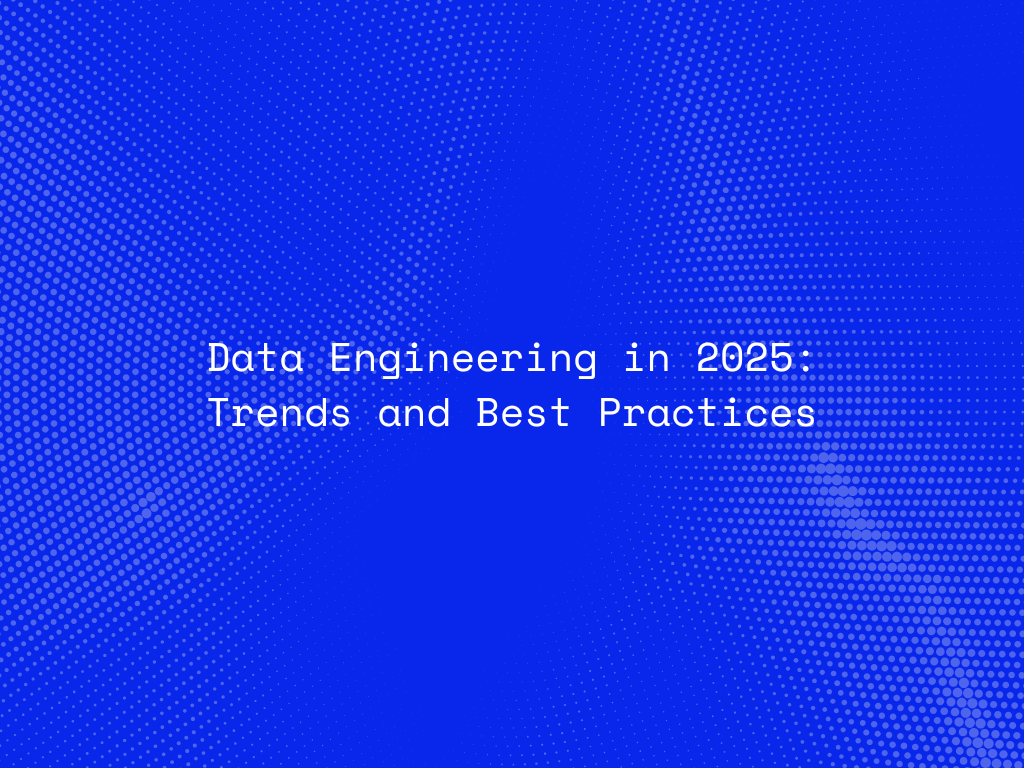The field of data engineering is at the center of digital transformation, enabling businesses to harness the power of vast amounts of data for AI, analytics, and decision-making. As we move into 2025, the evolution of data engineering is accelerating, driven by advancements in AI automation, cloud computing, real-time processing, and privacy-centric architectures. Organizations are moving beyond traditional data warehouses and lakes, adopting decentralized, scalable, and AI-powered data infrastructures.
To stay competitive, businesses must embrace the latest trends and best practices that define the future of data engineering. This article explores the key developments shaping data engineering in 2025, including AI-driven automation, the rise of data mesh, real-time analytics, and the growing emphasis on security and compliance.
Emerging Trends in Data Engineering for 2025
One of the most significant transformations in data engineering is the integration of AI and automation. In 2025, AI is playing an increasingly vital role in optimizing data pipelines, automating ETL workflows, and ensuring data quality. AI-powered monitoring systems are enabling real-time anomaly detection and self-healing data infrastructures, reducing manual intervention and improving overall efficiency. With machine learning models continuously refining data integration and governance processes, organizations can achieve faster insights and more accurate decision-making.
Another major shift is the move from centralized data lakes to decentralized data mesh architectures. The traditional model of storing all organizational data in a single repository is proving to be inefficient, leading to bottlenecks, increased latency, and security risks. Data mesh offers a decentralized approach where individual teams manage their own data domains, promoting scalability, autonomy, and better data discoverability. This shift is enabling businesses to democratize data access while maintaining robust security and governance frameworks.
Real-time data processing is becoming a necessity across industries, replacing traditional batch processing methods. With technologies such as Apache Kafka, Apache Flink, and AWS Kinesis, organizations can process data streams instantaneously, enabling faster insights and improved decision-making. Real-time analytics is particularly beneficial for industries like finance, healthcare, and e-commerce, where instant data-driven actions can enhance customer experience, prevent fraud, and optimize operations. The integration of edge computing and IoT devices is further amplifying the need for real-time data pipelines, ensuring that insights are delivered at the point of action.
Cloud-native and serverless data engineering is revolutionizing the way organizations handle infrastructure. Instead of managing physical servers, companies are leveraging serverless architectures that automatically scale based on demand. This approach not only reduces operational overhead but also optimizes costs by allowing businesses to pay only for the resources they use. Multi-cloud and hybrid cloud strategies are also gaining traction, ensuring greater flexibility, resilience, and compliance with data regulations across different regions.
As data volumes grow, so do concerns around privacy, security, and regulatory compliance. With strict data regulations such as GDPR, CCPA, and emerging AI governance frameworks, businesses must adopt a privacy-first approach to data engineering. AI-powered compliance monitoring tools are becoming essential, automatically detecting policy violations and ensuring adherence to global standards. Techniques such as federated learning and differential privacy are gaining popularity, allowing organizations to train AI models on decentralized datasets while preserving data security. Encryption, data masking, and access control mechanisms are also becoming more advanced, ensuring that sensitive information remains protected at every stage of data processing.
Best Practices for Modern Data Engineering
To thrive in this rapidly evolving landscape, organizations must adopt modern data engineering best practices that focus on efficiency, scalability, and security. A strong emphasis on data governance is critical to maintaining data integrity and compliance. By leveraging AI-driven data lineage tracking, policy enforcement, and access controls, businesses can ensure that their data remains trustworthy and well-managed. Implementing real-time monitoring solutions further enhances observability, enabling organizations to detect and resolve issues before they impact operations.
Scalability is another key factor in modern data engineering. As businesses generate and consume increasing volumes of data, designing resilient, fault-tolerant data pipelines is essential. Event-driven architectures, containerized workflows, and microservices-based data infrastructures are allowing organizations to scale dynamically while minimizing system failures. Adopting cloud-native technologies such as Kubernetes, Docker, and Terraform ensures that data pipelines remain agile and adaptable to evolving business needs.
The rise of open-source tools and frameworks is also playing a crucial role in modern data engineering. Technologies like Apache Spark, Flink, Airflow, and DBT are enabling organizations to build efficient, high-performance data workflows. These tools provide flexibility, interoperability, and cost-effectiveness, allowing data teams to focus on innovation rather than vendor lock-in. By leveraging open-source solutions, businesses can create highly customizable and scalable data architectures tailored to their specific requirements.
Self-service data platforms are becoming increasingly important, empowering business users and analysts to access and analyze data without relying on engineering teams. Data catalogs, metadata management platforms, and low-code/no-code analytics tools are streamlining data discovery and utilization. By enabling self-service access, organizations can improve data democratization, foster collaboration, and accelerate decision-making processes across departments.

Challenges Facing Data Engineering in 2025
Despite these advancements, data engineering faces several challenges that organizations must address to remain competitive. The increasing complexity of data ecosystems, driven by diverse data sources, unstructured formats, and multi-cloud environments, requires more sophisticated integration and processing techniques. Businesses must invest in AI-driven data orchestration tools to manage this complexity effectively.
Cost optimization is another major concern, particularly with the growing reliance on cloud-based data infrastructures. While cloud computing offers scalability and flexibility, inefficient data storage, processing, and retrieval mechanisms can lead to excessive costs. Implementing automated cost-monitoring tools and optimizing query performance are essential for maintaining cost efficiency without compromising performance.
Additionally, the demand for skilled data engineers continues to outpace supply, creating a talent gap in the industry. Organizations must invest in training, upskilling, and adopting AI-assisted automation to bridge this gap. By streamlining routine tasks through automation, data engineering teams can focus on more strategic initiatives, driving greater business value.
The Future of Data Engineering
Looking ahead, data engineering will continue to evolve, becoming more AI-driven, decentralized, and privacy-centric. Automation will play an even greater role in optimizing data workflows, reducing manual intervention, and enhancing efficiency. The adoption of self-serve data platforms will empower business users, while advancements in federated learning and differential privacy will ensure compliance with global data regulations.
Organizations that embrace these emerging trends and best practices will gain a competitive edge, transforming data into a strategic asset. By prioritizing scalability, security, and real-time analytics, businesses can unlock new opportunities, drive innovation, and maximize the value of their data ecosystems in the years to come.




